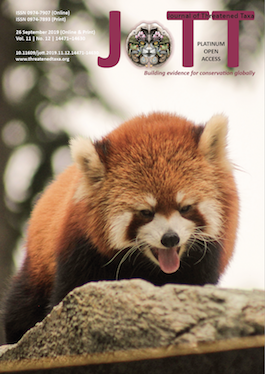Seasonal vegetation shift and wetland dynamics in vulnerable granitic rocky outcrops of Palghat Gap of southern Western Ghats, Kerala, India
DOI:
https://doi.org/10.11609/jott.4732.11.12.14518-14526Keywords:
Granitic hillocks, Palakkad, vegetation shift, wetland dynamicsAbstract
Low altitude granitic hillock systems prevalent in Palghat (Palakkad) Gap region of southern Western Ghats were analyzed for seasonal dynamics in wetland taxa associated with marshy ephemeral flush vegetation, small ephemeral pools and deep rock pools. Due to characteristic habitat features, such systems harbor a unique pattern of microhabitats and associated floristic components. Wet phase in rocky outcrops in the monsoon season establishes a hydro-geomorphic habitat that supports establishment of wetland taxa like Eriocaulon, Drosera, Utricularia, Dopatrium, and Rotala. Seasonal shift in the floral associations was evident in tune with wetland dynamics. Wet rocks support ephemeral flush vegetation which display some unique plant associations of species of Eriocaulon, Utricularia, Drosera, Cyanotis, Murdannia, and Lindernia. Small ephemeral pools displayed taxa like Rotala malampuzhensis R.V. Nair, Dopatrium junceum (Roxb.) Buch.-Ham. ex Benth., D. nudicaule (Willd.) Benth., Monochoria vaginalis (Burm.f.) C. Presl, and Cyperus iria L. Rocky pools are the habitats of aquatic angiosperms like Nymphaea nouchali Burm. f., Ludwigia adscendens (L.) H. Hara, Utricularia aurea Lour. and Hydrilla verticillata (L.f.) Royle. The study documented 121 plant taxa from 37 families during a wet phase from rocky outcrops of the study area. Gradual shift in vegetation is evident as water recedes from granitic hillocks. During the period from December to March, the rocky pools dry up which results in a shift in the vegetation pattern where Poaceae members form the dominant elements. As most of the rocky outcrops are exposed to extreme temperature and acute water shortage, the taxa inhabiting such ecosystems tend to evolve much faster than in other habitats. Moreover, the vicinity of these hillocks in the Palghat Gap region to human settlements, face threats like fire, grazing, quarrying, dumping of wastes etc. which may cause considerable loss to the very sensitive plant communities which are not yet fully documented.
References
Chase, M.W., M.J.M. Christenhusz, M.F. Fay, J.W. Byng, W.S. Judd, D.E. Soltis, D.J. Mabberley, A.N. Sennikov, P.E. Soltis, P.F. Stevens, B. Briggs, S. Brockington, A. Chautems, J.C. Clark, J. Conran, E. Haston, M. Moller, M. Moore, R. Olmstead, M. Perret, L. Skog, J. Smith, D. Tank, M. Vorontsova & A. Weber (2016). An update of the Angiosperm Phylogeny Group classification for the orders and families of flowering plants: APG IV. Botanical Journal of the Linnaean Society 181(1): 1–20. https://doi.org/10.1111/boj.12385
Cruz, E.D., P.K.R. Nair & V. Prasannakumar (2000). Palghat Gap-A dextral shear zone from the south Indian granulite terrain. Gondwana Research 3(1): 21–31. https://doi.org/10.1016/S1342-937X(05)70054-X
Fitzsimons, J.A. & D.R. Michael (2017). Rocky outcrops: A hard road in the conservation of critical habitats. Biological Conservation 211: 36–44. https://doi.org/10.1016/j.biocon.2016.11.019
Hopper, S.D. & P.C. Withers (1997). Granite outcrops symposium proceedings, September 14–15, 1996. Journal of the Royal Society of Western Australia 80: 87–237.
IUCN (2019). The IUCN Red List of Threatened Species. Version 2019-2. http://www.iucnredlist.org. Downloaded on 01 September 2019.
Jose, S., V. Suresh, R. Prakashkumar & P.V. Madhusoodanan (2013). Dipcadi montanum (Dalzell) Baker - An addition to the flora of Kerala, India. Journal of Bombay Natural History Society 110(3): 237.
Jose, S., M.C. Nair, K.M. Prabhukumar, V.V. Asha, R.P. Kumar, P.V. Madhusoodanan & V. Suresh (2015). Oldenlandia dineshii (Rubiaceae: Spermacoceae), a new species from the Palakkad Gap region of Western Ghats, India. Kew Bulletin 70(13): 1–5. https://doi.org/10.1007/s12225-015-9564-y
Pramod, C., A.K. Pradeep & C.C. Harilal (2014). Seasonal pools on lateritic plateaus: Unique habitats of great diversity - a case study from northern Kerala. Journal of Aquatic Biology and Fisheries 2: 458–466.
Sasidharan, N. (2014). Flowering plants of Kerala, Version 2.0. CD Rom. KFRI, Peechi. Accessed on 01 September 2019.
Sreejith, K.A., P. Prashob, V.B. Sreekumar, H.P. Manjunatha & M.P. Prejith (2016). Microhabitat diversity in a lateritic hillock of northern Kerala, India. Vegetos 29(3): 1–11.
Published
Issue
Section
License
Authors own the copyright to the articles published in JoTT. This is indicated explicitly in each publication. The authors grant permission to the publisher Wildlife Information Liaison Development (WILD) Society to publish the article in the Journal of Threatened Taxa. The authors recognize WILD as the original publisher, and to sell hard copies of the Journal and article to any buyer. JoTT is registered under the Creative Commons Attribution 4.0 International License (CC BY), which allows authors to retain copyright ownership. Under this license the authors allow anyone to download, cite, use the data, modify, reprint, copy and distribute provided the authors and source of publication are credited through appropriate citations (e.g., Son et al. (2016). Bats (Mammalia: Chiroptera) of the southeastern Truong Son Mountains, Quang Ngai Province, Vietnam. Journal of Threatened Taxa 8(7): 8953–8969. https://doi.org/10.11609/jott.2785.8.7.8953-8969). Users of the data do not require specific permission from the authors or the publisher.





